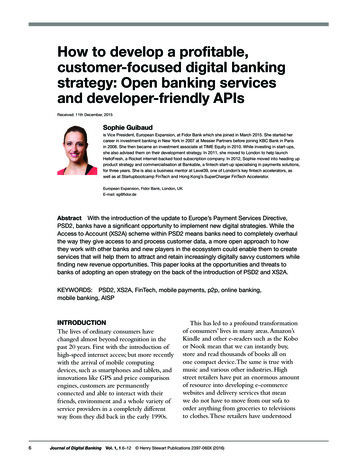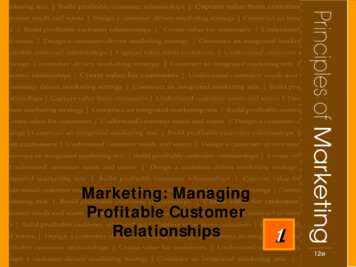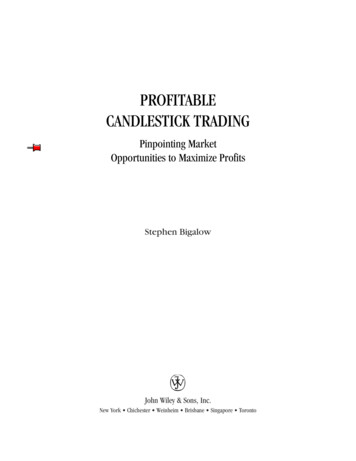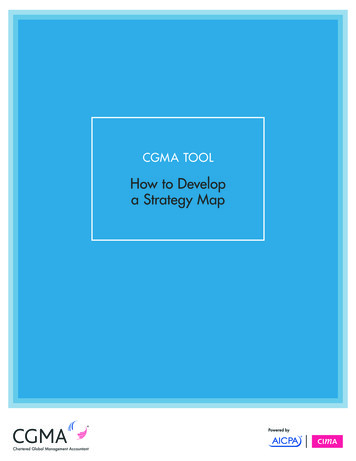
Transcription
How to develop a profitable,customer-focused digital bankingstrategy: Open banking servicesand developer-friendly APIsReceived: 11th December, 2015Sophie Guibaudis Vice President, European Expansion, at Fidor Bank which she joined in March 2015. She started hercareer in investment banking in New York in 2007 at Messier Partners before joining KBC Bank in Parisin 2008. She then became an investment associate at TIME Equity in 2010. While investing in start-ups,she also advised them on their development strategy. In 2011, she moved to London to help launchHelloFresh, a Rocket internet-backed food subscription company. In 2012, Sophie moved into heading upproduct strategy and commercialisation at Bankable, a fintech start-up specialising in payments solutions,for three years. She is also a business mentor at Level39, one of London’s key fintech accelerators, aswell as at Startupbootcamp FinTech and Hong Kong’s SuperCharger FinTech Accelerator.European Expansion, Fidor Bank, London, UKE-mail: sg@fidor.deAbstract With the introduction of the update to Europe’s Payment Services Directive,PSD2, banks have a significant opportunity to implement new digital strategies. While theAccess to Account (XS2A) scheme within PSD2 means banks need to completely overhaulthe way they give access to and process customer data, a more open approach to howthey work with other banks and new players in the ecosystem could enable them to createservices that will help them to attract and retain increasingly digitally savvy customers whilefinding new revenue opportunities. This paper looks at the opportunities and threats tobanks of adopting an open strategy on the back of the introduction of PSD2 and XS2A.Keywords: PSD2, XS2A, FinTech, mobile payments, p2p, online banking,mobile banking, AISPINTRODUCTIONThe lives of ordinary consumers havechanged almost beyond recognition in thepast 20 years. First with the introduction ofhigh-speed internet access; but more recentlywith the arrival of mobile computingdevices, such as smartphones and tablets, andinnovations like GPS and price comparisonengines, customers are permanentlyconnected and able to interact with theirfriends, environment and a whole variety ofservice providers in a completely differentway from they did back in the early 1990s.6Journal of Digital BankingThis has led to a profound transformationof consumers’ lives in many areas. Amazon’sKindle and other e-readers such as the Koboor Nook mean that we can instantly buy,store and read thousands of books all onone compact device. The same is true withmusic and various other industries. Highstreet retailers have put an enormous amountof resource into developing e-commercewebsites and delivery services that meanwe do not have to move from our sofa toorder anything from groceries to televisionsto clothes. These retailers have understoodVol. 1, 1 6–12 Henry Stewart Publications 2397-060X (2016)
How to develop a profitable, customer-focused digital banking strategythat it was not only important for theircustomers to be able to order anything theylike online but also to have the smoothestbuying experience possible, with personalisedrecommendations based on their buyinghabits and those of people with similarprofiles, seamless and secure payments,express delivery and so on.Other areas of life have not been changednearly as much by this digital ‘revolution.’Banking is one of these areas. It is not asif there has not been interest in onlinebanking — figures from the British BankingAssociation show that there are 9.6 millioninternet bank logins in the United Kingdomevery day, while 2015 was also the year thatmobile banking logins overtook branchinteractions for the first time.1 In 2014,44.1 per cent of EU citizens used onlinebanking services — this figure was 56.8 percent in the United Kingdom.2 But bankshave had to face many challenges over thepast 15 years, including their legacy mainbanking systems dating back from the 1970s,more stringent regulations and lower ITbudgets — stemming directly from repeatedfinancial crises in the 2000s. Organisationalinadaptability with strong hierarchyand numerous stakeholders involved inany decision has also been a challenge,compounded by the fact that many haveno real processes in place to listen to theircustomers.While one could argue that onlineservices and mobile apps that let customerscheck their balance and even move money atany time of day or night does represent a seachange in the banking industry, the currentcrop of digital services offered by banksdoes not go nearly far enough. Consumersare still expecting much more from theirbanks, including a differentiated offering — aclear USP, real-time and forward-lookingpersonal finance analysis and personalisedoffers suited to their needs — not the bank’starget revenues. In a survey conducted in theUnited States in 2014, 53 per cent of peopledid not think their bank offered anythingdifferent from other banks.3 The inabilityof customers to get what they want hasdriven the increased popularity of fintechcompanies, which have been focusing oncustomer experience and alternative businessmodels to differentiate themselves.Fortunately for customers, the update tothe European Payment Services Directive,PSD2,4 should be the catalyst for a wave ofinnovation and customer-focused services.While the short-term impact on banks couldbe quite painful as they will need to organisearound it, the XS2A provision within PSD2will represent an opportunity for them toserve their clients better while finding newrevenue streams for those who decide toembrace it by going beyond the minimumrequirement of the directive.WHAT DO CUSTOMERS WANT?The banking industry’s failure to keep upwith innovations in other technology-reliantindustries means that it has also fallen behindwhen it comes to customer expectations. Ifcustomers are being offered numerous toolsand features that make their lives easier inother areas, they soon become frustratedwith services that do not offer them similarlevels of convenience and choice. Customersvote with their feet, and if banks want tocontinue to be profitable and relevant inthe financial services value chain, they musttransform themselves.So, while banks have to accept that thewider digital revolution has greatly increasedcustomer expectations of what to expectfrom modern life, they then need to askwhat it is they can be doing to meet theseexpectations.While the banks have struggled togive customers what they want to date, awave of innovators have been moving into fill the gaps. Companies like Mint andMoneyDashboard are helping ordinarycustomers get a much better overview oftheir finances — account balances, utility bills,loan repayments and so on — all in one place. Henry Stewart Publications 2397-060X (2016)Vol. 1, 1 6–12 Journal of Digital Banking7
GuibaudIn short, customers banking services thathelp them plan their budgets, make paymentsmore easily, forecasting tools for savingsand pensions, discounted offers adapted totheir spending habits and the like — notjust to view statements and make transfers.A Gartner study from 2014 predictedthat 25 per cent of the Top 50 GlobalBanks will launch a banking ‘app store’ forcustomers — something that Credit Agricolehas already done — illustrating the belief thatthese customers also want all of this presentedin a more cohesive way. Having access toall of the services in one place will makea consumer’s life much more convenientthan having to go to a number of differentwebsites or apps to carry out each task.Happily for the end user, provisions withinPSD2 under the XS2A scheme mean thatbanks will be required to open up customerdata to third-party software and appproviders, giving at the same time the banksthe opportunity to integrate third-partyservices into their platform — somethingsome banks like Fidor are already doing withSmava and Currency Cloud.OPEN APIsThe mechanism by which XS2A is to beimplemented is not yet confirmed, but itis expected that it will be achieved by theuse of open application program interfaces(APIs). These are effectively a set of tools thatallows new feature sets and services to beplugged into existing platforms. Open APIsare nothing new in online services — in fact,Salesforce was using them as far back as 2000and opened an app store for its customers in2006. To put this in some context, Apple’sApp Store, providing apps for the iPhone, didnot open its doors until 2008. And even then,it was not yet open to third parties.In the past decade, APIs have allowedorganisations that hold large amounts ofdata to become platforms for third-partyinnovation. Google, Twitter and Facebookoffer APIs to third parties, and in the8Journal of Digital Bankingpayment space PayPal has pioneered openAPIs since 2010, spawning a whole newecosystem. In fact, the financial sector hasseen more APIs launched than any othersector except for social media,5 somethingthat has played a important part in thedevelopment and growth of fintech.While APIs are something that banksalready use for the exchange of data withintheir own systems and with establishedpartners, opening up these APIs to thirdparties is a completely different matter.Until now, banks have been the sole, trustedguardian of customer data information,and the regulations are akin to them beingforced to open up their jewellery box and leteveryone rummage around.So, although this change is creating a lotof opportunities, it is also causing a numberof headaches for the banks. The first andmost obvious is that banks need to ensurethat customer data is shared in a safe andsecure way with third parties. The regulatorytechnical standards for these APIs will bedefined by the European Banking Authority(EBA), so the first step to doing this is toensure that you understand these standardsand build the APIs accordingly.They also need to create the front-endinterfaces for third parties to access this data,which will be a time-consuming process fullof challenges — banks will have to deal withthe process of integrating these interfacesinto their important banking systems inorder for the data to be extracted and shared.If the important banking system in questionis a number of years old, this processbecomes even more complex.But to take advantage of the opportunities,banks need to do this quickly while keepingan eye on costs.There is an even greater risk, although,of disintermediation. If customers can useservices that link to their bank account, butdo so outside of the bank’s online bankingwebsite or app, then these customersno longer have the bank at the front oftheir mind.Vol. 1, 1 6–12 Henry Stewart Publications 2397-060X (2016)
How to develop a profitable, customer-focused digital banking strategyTHE ADVANTAGE OF BEING AN AISPThere is an opportunity — the banks needto be aware of with XS2A. Under thenew directive, there will be a new way ofcarrying out online transactions withoutusing cards — great news for those who donot want to use their card or do not haveone. If a customer buys something from aretailer online and pays for their purchasefrom their current account, the customer willsimply give the retailer permission to executepayments on their behalf via their currentaccount — this would only have to happenfor the first purchase, and the permissionwould remain valid until the customer saysthat it is not.In the earlier example, the bank playsthe role of the Account Servicing PaymentService Provider (ASPSP). However,banks are also in a position to become anAccount Information Service Provider(AISP), under PSD2 regulations. This iswhere it consolidates information from avariety of ASPSPs, meaning all the detailsof an individual’s different accounts areall in one place, and can present them allto the customer in a dashboard and evenallow customers and merchants to completetransactions that do not involve accounts thatthey hold.Although there are several companiessuch as Mint that already present a dashboardview of multiple accounts, XS2A will see anumber of other organisations — whethertraditional banks or not — enter this space inan attempt to become the interface throughwhich a customer views and manages theirfinances. The bank has an opportunity tobe the AISP that remains front-of-mind fortheir customers — and if they tie this inwith an app store-like experience, they putthemselves in a very strong position — butalso the threat of becoming as good asinvisible to the people who hold accountswith it if they decide not to become an AISP.So, the question is: will it be fintechcompanies or banks becoming the primaryinterface for the personal finances of theircustomers? With PSD2 coming into force in2017, both types of organisations have theirchance, but only if they realise what is atstake.COMPETE OR COLLABORATE?With the fintech revolution that is takingplace in Europe — where many of the mostinteresting companies linking themselvesto London’s heritage in the financialservices industry — banks have a fantasticopportunity to expand the number ofservices that they have available to theircustomers, as well as integrate currentaccount balances and transactions from otherbanks into their own services in order tobecome the primary interface a customeruses.The relationship between some banksand these fintech innovators is already, tosome extent, symbiotic. After all, thesecompanies rely on existing banks to providethem with accounts so they can get setup, and sometimes even on their bankinglicence to operate. The banks, in turn, arestarting to take advantage with partnershipsand the like — take GoCardless as just oneexample, which has partnered with severalof Europe’s biggest banks. These partnershipscan work in a number of ways — they canbe white-labelled, for example, with Fidor’suse of Currency Cloud’s payment engine6;or where the partner still retains their ownbranding, but delivers the service throughthe bank’s platform, such as with MetroBank’s partnership with peer-to-peer lending
internet bank logins in the United Kingdom every day, while 2015 was also the year that mobile banking logins overtook branch interactions for the first time.1 In 2014, 44.1 per cent of EU citizens used online banking services — this figure was 56.8 per cent in the United Kingdom.2 But banks have had to face many challenges over the











